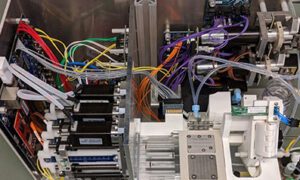In today’s race to build more intelligent machines, the real breakthroughs aren’t in what AI can generate, they’re in what it can understand. For Rohit Jacob, a seasoned data scientist and applied AI researcher, intelligence isn’t just about response accuracy or model size. It’s about context, memory, behavior modeling, and adaptation. It’s about building systems that reason, anticipate, and learn, not just react.
With over eight years of experience designing and deploying machine learning systems across logistics, e-commerce, and generative AI, Rohit has led projects that turn AI from novelty into necessity. Whether it’s powering smarter parcel delivery or building large-scale personalization pipelines, his work consistently centers around a simple but powerful principle: make AI more useful by making it more human-aware.
From Presence to Personalization: Designing for Intelligent Context
A core challenge in applied AI is teaching systems not just to answer, but to understand. Rohit’s approach draws inspiration from ambient intelligence, where machine behavior is shaped by nuanced signals, user location, preferences, prior interactions, and even silence.
His thinking mirrors principles that underpin transformative work like the Alexa Presence Proactive Events Framework, where systems had to detect who was present, infer intent, and trigger personalized actions based on proximity. That project, which powered Alexa Together, Follow Me Music, and other key features, relied on intelligent fusion of BLE signals, interaction events, and decaying signal models to ensure timely, privacy-preserving inference at scale. Much like that architecture, Rohit’s AI systems are built around contextual adaptability: understanding who the user is, what they need now, and how to respond appropriately across touchpoints.
This design philosophy shows in his work on retrieval-augmented generation (RAG) systems, where foundational models are equipped with contextual memory. Instead of treating every user query as a cold start, these agents adapt their responses based on historical activity, onboarding status, and user goals. “Personalization isn’t about recommending the next item,” Rohit explains. “It’s about optimizing the entire user journey, from first interaction to long-term retention, with minimal friction and maximal relevance.”
Intelligent Interfaces: Building Systems That Interpret, Not Just React
Rohit is also the inventor on two U.S. patents that explore how AI can better interface with humans. One patent focuses on dynamically generating user interface elements from natural language, allowing systems to convert verbal input into functional UI components. This technology has implications for low-code development, accessibility, and adaptive app design, where traditional menus and buttons give way to intelligent, real-time customization.
The second patent outlines a system for modifying search relevance based on visual interactions, enabling smarter results by interpreting how users engage with images, not just what they type. These inventions reflect Rohit’s long-standing belief that machine understanding starts with user behavior, not just model architecture.
“We often design AI systems as oracles, answering static questions,” he says. “But real value comes from AI that can watch, learn, and evolve with the user.”
Forecasting with Bayesian Precision and Human Intuition
Before diving into generative AI, Rohit tackled one of the thorniest problems in logistics: predicting delivery accurately across vast, volatile supply networks. He designed and implemented Bayesian forecasting pipelines that integrated structured time-series data with exogenous factors like seasonality, geography, and carrier performance. By accounting for patterns such as holiday surges and regional variations, the models reduced parcel delivery errors, improved customer satisfaction, and lowered logistics costs at enterprise scale.
This work, while highly technical, was also deeply operational. Rohit’s solutions had to align with fulfillment SLAs, integrate with internal APIs, and handle real-world data noise without collapsing. “Forecasting isn’t about getting the number right,” he explains. “It’s about creating enough certainty that operations can move forward without fear.”
Scaling Generative AI Systems with RAG and Feedback Loops
In the generative world, Rohit has turned his focus to LLM alignment. At a time when many teams rush to deploy foundation models as is, Rohit leads efforts to refine them post-deployment: tuning them with retrieval pipelines, user feedback, and reward models that close the loop between generation and outcome.
His recent work focused on building the feedback loop for Shopify Sidekick, where he explored how users actually wanted to interact with the agent and worked to make the experience feel more personalized. Rather than assuming user needs, his approach emphasized learning directly from user behavior to continuously refine Sidekick’s responses, surface more relevant content and guidance over time. “If you want generative AI to create value,” he says, “you need to treat every output as a hypothesis, and test it against user behavior.”
Beyond the technical work, Rohit has served as a judge for the Globee Awards in Technology, evaluating innovations through both engineering and ethical lenses. He brings a systems-level view that blends theory, experimentation, and user empathy. He sees AI not as a black box, but as an interface between logic and life, a reflection of how people think, decide, and adapt.
The Future Is Responsive, Not Reactive
As LLMs and agents continue to shape the future of computing, Rohit Jacob’s work offers a critical reminder: intelligent systems are only as powerful as the environments they respond to. Whether it’s a smart speaker detecting who’s in the room, or a RAG platform surfacing the right insight at the right time, real-world intelligence comes from design, not just data.
In a world moving rapidly toward automation, Rohit is building the frameworks that ensure AI stays responsive, responsible, and relevant. Because at the end of the day, the most powerful systems aren’t the ones that say the most, they’re the ones that listen best.





























